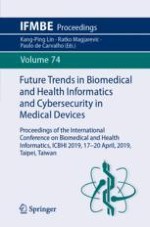2020 | OriginalPaper | Buchkapitel
Real-Time Intelligent Healthcare Monitoring and Diagnosis System Through Deep Learning and Segmented Analysis
verfasst von : Edward B. Panganiban, Wen-Yaw Chung, Wei-Chieh Tai, Arnold C. Paglinawan, Jheng-Siang Lai, Ren-Wei Cheng, Ming-Kai Chang, Po-Hsuan Chang
Erschienen in: Future Trends in Biomedical and Health Informatics and Cybersecurity in Medical Devices
Aktivieren Sie unsere intelligente Suche, um passende Fachinhalte oder Patente zu finden.
Wählen Sie Textabschnitte aus um mit Künstlicher Intelligenz passenden Patente zu finden. powered by
Markieren Sie Textabschnitte, um KI-gestützt weitere passende Inhalte zu finden. powered by
